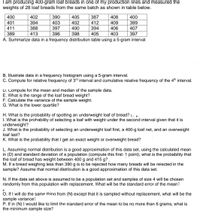
MATLAB: An Introduction with Applications
6th Edition
ISBN: 9781119256830
Author: Amos Gilat
Publisher: John Wiley & Sons Inc
expand_more
expand_more
format_list_bulleted
Question
.........ajxdkeiams.....
Answer only D upto P

Transcribed Image Text:I am producing 400-gram loaf breads in one of my production lines and measured the
weights of 28 loaf breads from the same batch as shown in table below.
400
402
390
405
387
408
400
401
394
403
402
412
409
399
411
388
397
400
394
406
407
389
413
396
398
405
403
397
A. Summarize data in a frequency distribution table using a 5-gram interval.
B. Illustrate data in a frequency histogram using a 5-gram interval.
C. Compute for relative frequency of 3rd interval and cumulative relative frequency of the 4th interval.
D. Compute for the mean and median of the sample data.
E. What is the range of the loaf bread weight?
F. Calculate the variance of the sample weight.
G. What is the lower quartile?
H. What is the probability of spotting an underweight loaf of bread? .
I. What is the prohability of selecting a loaf with weight under the second interval given that it is
underweight?
J. What is the probability of selecting an underweight loaf first, a 400-g loaf net, and an overweight
loaf last?
K. What is the probability that I get an exact weight or overweight bread?
L. Assuming normal distribution is a good approximation of this data set, using the calculated mean
in (D) and standard deviation of a population (compute this first: 1 point), what is the probability that
the loaf of bread has weight between 400 g and 415 g?
M. If a bread weighing less than 390 g
sample? Assume that normal distribution is a good approximation of this data set.
to be rejected how many breads will be reiected in the
N. If the data set above is assumed to be a population set and samples of size 4 will be chosen
randomly from this population with replacement. What will be the standard error of the mean?
O. If I will do the same thing from (N) except that it is sampled without replacement, what will be the
sample variance?
P. If in (N) I would like to limit the standard error of the mean to be no more than 6 grams, what is
the minimum sample size?
Expert Solution
This question has been solved!
Explore an expertly crafted, step-by-step solution for a thorough understanding of key concepts.
Step by stepSolved in 3 steps with 2 images

Knowledge Booster
Similar questions
- tol. What is li'm Tantl 계arrow_forwardWhich of the following could be the number of players on each team?arrow_forwardB. 3. A painting is available as a 60-inch-wide by 48-inch-long canvas. If the painting is also available as a 42-inch-long canvas, what is the width of the painting? A. 33.6 inches B. 36.2 inches C. 52.5 inches D. 54.8 inchesarrow_forward
arrow_back_ios
arrow_forward_ios
Recommended textbooks for you
 MATLAB: An Introduction with ApplicationsStatisticsISBN:9781119256830Author:Amos GilatPublisher:John Wiley & Sons Inc
MATLAB: An Introduction with ApplicationsStatisticsISBN:9781119256830Author:Amos GilatPublisher:John Wiley & Sons Inc Probability and Statistics for Engineering and th...StatisticsISBN:9781305251809Author:Jay L. DevorePublisher:Cengage Learning
Probability and Statistics for Engineering and th...StatisticsISBN:9781305251809Author:Jay L. DevorePublisher:Cengage Learning Statistics for The Behavioral Sciences (MindTap C...StatisticsISBN:9781305504912Author:Frederick J Gravetter, Larry B. WallnauPublisher:Cengage Learning
Statistics for The Behavioral Sciences (MindTap C...StatisticsISBN:9781305504912Author:Frederick J Gravetter, Larry B. WallnauPublisher:Cengage Learning Elementary Statistics: Picturing the World (7th E...StatisticsISBN:9780134683416Author:Ron Larson, Betsy FarberPublisher:PEARSON
Elementary Statistics: Picturing the World (7th E...StatisticsISBN:9780134683416Author:Ron Larson, Betsy FarberPublisher:PEARSON The Basic Practice of StatisticsStatisticsISBN:9781319042578Author:David S. Moore, William I. Notz, Michael A. FlignerPublisher:W. H. Freeman
The Basic Practice of StatisticsStatisticsISBN:9781319042578Author:David S. Moore, William I. Notz, Michael A. FlignerPublisher:W. H. Freeman Introduction to the Practice of StatisticsStatisticsISBN:9781319013387Author:David S. Moore, George P. McCabe, Bruce A. CraigPublisher:W. H. Freeman
Introduction to the Practice of StatisticsStatisticsISBN:9781319013387Author:David S. Moore, George P. McCabe, Bruce A. CraigPublisher:W. H. Freeman

MATLAB: An Introduction with Applications
Statistics
ISBN:9781119256830
Author:Amos Gilat
Publisher:John Wiley & Sons Inc

Probability and Statistics for Engineering and th...
Statistics
ISBN:9781305251809
Author:Jay L. Devore
Publisher:Cengage Learning

Statistics for The Behavioral Sciences (MindTap C...
Statistics
ISBN:9781305504912
Author:Frederick J Gravetter, Larry B. Wallnau
Publisher:Cengage Learning

Elementary Statistics: Picturing the World (7th E...
Statistics
ISBN:9780134683416
Author:Ron Larson, Betsy Farber
Publisher:PEARSON

The Basic Practice of Statistics
Statistics
ISBN:9781319042578
Author:David S. Moore, William I. Notz, Michael A. Fligner
Publisher:W. H. Freeman

Introduction to the Practice of Statistics
Statistics
ISBN:9781319013387
Author:David S. Moore, George P. McCabe, Bruce A. Craig
Publisher:W. H. Freeman